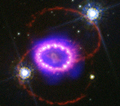Speaker
Dr
Patrick BLOTTIAU
(CEA, DAM, DIF, Arpajon, France and Laboratoire Univers et Théories, Observatoire de Paris, Meudon, France)
Description
A complete description of the core-collapse supernova mechanism requires an
appropriate treatment of both the hydrodynamics and the microphysics.
Indeed, despite the crucial role played by hydrodynamics (e.g. hydrodynamical
instabilities, rotation, convection or General Relativistic effects), to produce type
II supernovae explosions, the influence of nuclear physics inputs on the outcome of
the simulations is far from being unimportant.
Using our spherically symmetric (1D) Newtonian hydro code [1], we evaluate the impact
of the temperature dependence of the nuclear symmetry energy [2] during the
core-collapse and early post-bounce phase. We found a systematic reduction of the
deleptonization during collapse for different electron capture rates [3,4] and a
shift of the position of the formation of the shock outwards of a significative amount.
We also plan to investigate such microphysics effects in the General Relativity
framework [5,6,7].
We believe that the introduction of such a temperature dependence in multidimensional
simulations should be considered.
[1] P. Blottiau, Ph.D. thesis, Paris VII University (1989)
[2] A.F. Fantina, P. Donati and P.M. Pizzochero, Phys. Lett. B 676 (2009) 140
[3] S.W. Bruenn, Astrophys. J. Suppl. 58 (1985) 771
[4] K. Langanke, G. Martinez-Pinedo, J. M. Sampaio et al., Phys. Rev. Lett. 90 (2003)
241102
[5] J.V. Romero, J.M. Ibanez, M. Marti and J.A. Miralles, Astrophys. J. 462 (1996) 869
[6] J.A. Pons, J.A. Miralles and J.M. Ibanez, Proceedings of Spanish Relativity
Meeting (1996)
[7] A.F. Fantina, PhD thesis, Université Paris Sud and Università degli Studi di
Milano (2010)
Primary author
Dr
Patrick BLOTTIAU
(CEA, DAM, DIF, Arpajon, France and Laboratoire Univers et Théories, Observatoire de Paris, Meudon, France)
Co-authors
Dr
Anthea FANTINA
(Institut d'Astronomie et d'Astrophysique, Université libre de Bruxelles, Brussels, Belgium)
Dr
Jérôme MARGUERON
(Institut de Physique Nucléaire, Orsay, France)
Dr
Philip MELLOR
(CEA, DAM, DIF, Arpajon, France)
Dr
Pierre PIZZOCHERO
(Università degli Studi di Milano and Istituto Nazionale di Fisica Nucleare sez. di Milano, Milano, Italy)

